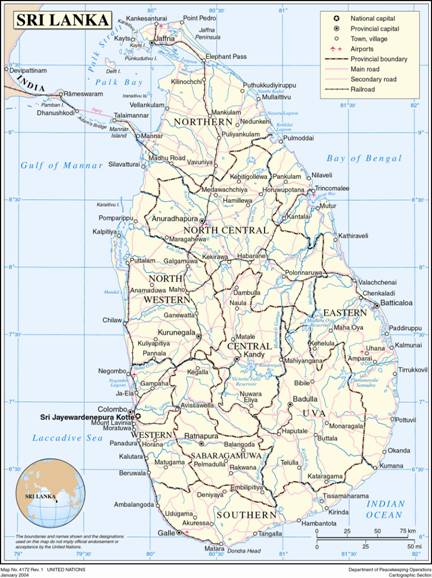Sri Lanka: Blackouts and Blockades
No respite for internally displaced persons in war-ravaged Sri Lanka
Commentary by Animesh Roul, ISN Security Watch, Zurich, September 22, 2006
|
The general perception is that the Colombo administration is openly flaunting international law by using humanitarian services as a weapon of war and by placing many parts of the Northeast under information blackout and essential items blockade.
|
The humanitarian crisis that has emerged due to the conflicts in northeast Sri Lanka has reached a crucial phase. The Sri Lankan government forces have resorted to indiscriminate assaults, targeting civilian areas while, at the same time, blocking relief materials and supplies to internally displaced persons (IDP) and enacting stringent directives for aid agencies.
This twin track strategy has proven to be detrimental to the thousands of civilians affected by the resumption of hostilities between Sri Lankan forces and Liberation of Tamil Tigers Eelam (LTTE) rebels in May 2006.
Another obvious concern for aid agencies is the personal security of aid workers and volunteers in the country, especially after the death of 17 volunteers working for French aid agency Action Against Hunger in early July.
The general perception is that the Colombo administration is openly flaunting international law by using humanitarian services as a weapon of war and by placing many parts of the Northeast under information blackout and essential items blockade.
An estimated 200,000 people, mostly Tamils, have been displaced internally and spread across northeastern Sri Lanka. The World Food Programme (WFP) has placed the number even higher, adding another 40,000 people. After a short respite in the violence in late August, renewed fighting in Trincomalee district has put an end to the return of refugees from areas close to Kanthale and Muttur.
In addition, over 11,000 Tamil refugees have arrived on the shores of southern India since January this year. They alleged that due to harassment by the Sri Lankan navy and military personnel, they could no longer continue with their traditional fishing activities for livelihood. Many of them sold off their fishing boats and nets to pay for the perilous one-hour sea voyage over the Palk Strait from Talai Mannar in Sri Lanka to Rameswaram in India.
 At least 10 refugees drowned in May 2005 when their boat capsized off the Indian coast. In addition, many refugees are at the risk of human traffickers who operate obsolete and overcrowded vessels and overcharge for the voyage. At least 10 refugees drowned in May 2005 when their boat capsized off the Indian coast. In addition, many refugees are at the risk of human traffickers who operate obsolete and overcrowded vessels and overcharge for the voyage.
Refugee influx to India lessened during the first quarter of this year, possibly due to peace talks between the rebels and the government, but rose during April and May after offensives unleashed by LTTE on government forces in and around Trincomalee and elsewhere.
Nevertheless, these numbers do not reflect the actual refugee situation that has been aggravated by the ongoing conflict, as being granted permission to visit the areas hosting IDP is difficult for humanitarian agencies.
Indeed, access to food and medicine has been restricted in locations such as Jaffna, Kilinochchi, Mullaitivu, Batticaloa and Ampara due to indiscriminate shelling, mortar attacks and mines.
Though freedom of movement inside rebel-held areas is still restricted, there is some respite for the people of the Batticaloa district where significant numbers of IDPs have moved due to the UN agencies, the Red Cross and the Sri Lanka Monitoring Mission (SLMM) having access to the most remote areas.
Alarmingly, food and other basic supplies at the disposal of various aid agencies along with local food stocks are depleting fast. Any chance of re-supply is difficult under the present state of affairs. Most of the aid agencies blame the Colombo administration for this deepened humanitarian crisis.
The WFP's operations have been severely hampered by the restricted opening of the Omanthai crossing into the Vanni, which is a LTTE-controlled area in the north. The agency’s Selvi Sachithanandam told ISN Security Watch that the UN body “plans to provide basic food rations to all 240,000 IDP [in the area] but their high degree of mobility as well as limited humanitarian access presents significant challenges in programming and pre-positioning of food.”
The UN Common Humanitarian Action Plan (CHAP), launched in Geneva in last month, has already appealed for a total of US$37.46 million to provide shelter, emergency supplies and protection for the displaced as part of a joint UN humanitarian action plan for the war ravaged country. The WFP has already delivered 2,583 tons of mixed food commodities to newly displaced people and have pledged more in the coming days.
Hopefully, this will not prove too little and too late for the people caught between the devil and deep sea.
Animesh Roul is ISN Security Watch's senior correspondent in India.
|  Home
Home Archives
Archives Home
Home Archives
Archives